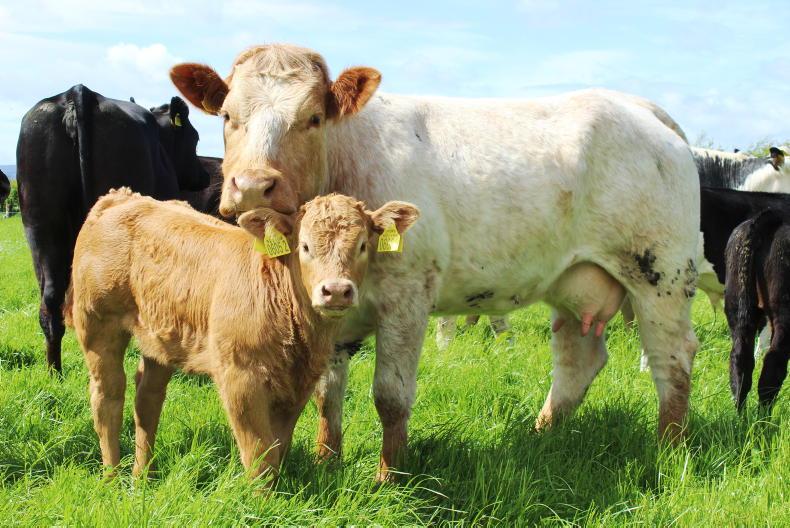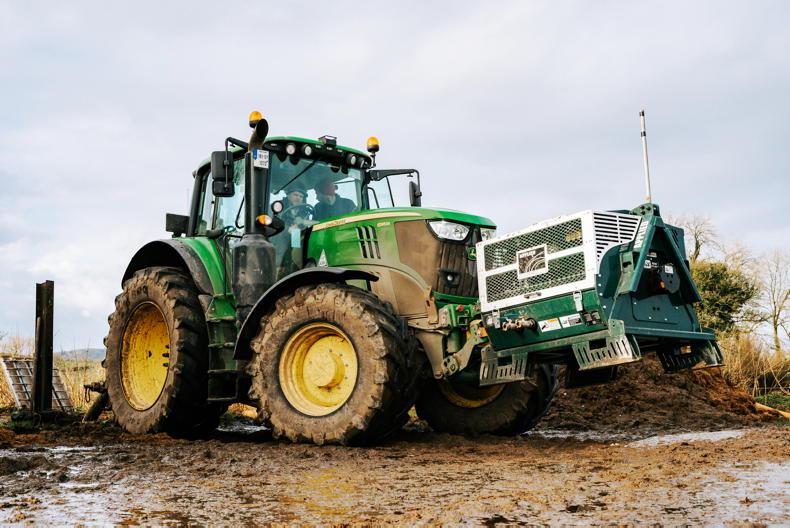In recent weeks, there has been some easing in the cost of fuel and fertiliser, while livestock rations have started the year on a steady footing.
Despite this, these input costs are still running considerably higher year-on-year. As such, what is it likely to cost a livestock farmer to keep a suckler cow in 2023?
Global markets continue to experience huge volatility, so where input prices settle this year is impossible to predict.
Gas and oil prices in early January are back below their equivalent value prior to the Russian invasion of Ukraine, fueling expectations that fertiliser will see further market corrections this year.
Feed prices are also affected by oil prices, as does extreme weather patterns on global grain markets.
Example herd
In an effort to put a value on the cost of keeping suckler cows, our analysis is based on a suckler farmer operating 60 spring-calving continental cows.
Cows are generally calved in a compact block over February and March. The majority of calves are sold as weanlings in October, with 15 lighter calves housed for 90 days to increase sale weight.
For simplicity, the farmer operates an “all-in, all out” system with eight in-calf heifers purchased from the same breeder every winter to replace cull and empty cows.
The farmer operates a grass-based system on owned land, which is relatively productive ground capable of grazing livestock from early April to the end of October.
The example assumes the same input levels are purchased annually as in recent years to support production at its current levels.
Fixed costs of £456/cow are included to cover expenses like insurance, diesel and machinery repairs, and are similar to 2022 levels, but 25% higher than the 2021 fixed costs of £365.
Calving to turnout
As cows calve from February and March to target the autumn weanling sales, the average date for calf births is set as 1 March as a mid-point.
Cows remain housed from calving until turnout on 10 April. During the 40-day period from calving until turnout, cows eat 45kg/day of silage (£20/t) and 2kg/day of concentrate (£350/t).
Straw for calving pens and creep areas is factored in at one round bale per cow, costing £18, which is lower than the previous year.
Miscellaneous costs for calving aids, ear tags etc are taken at £25/cow, with fixed costs amounting to £50/cow, bringing production costs for this period to £148/cow.
Grazing season
All cows are grazed from 10 April up to 20 October, at which point calves are sold live through the autumn weanling sales. In reality, some of the stronger calves may be sold at the outset of the month rather than selling everything on one day.
As ground is relatively good, stocking rate is taken as one cow and calf per acre. Four bags/ac of CAN will be spread over 2023, which is purchased in January at £650/t.
This means over the 60 cows, grazing fertiliser comes to £130/cow. Silage is made in two cuts on 35ac of land.
Assuming three bags/ac of CAN for first cut, then 2.5/bags/ac for second cut, requires 10t of CAN, bringing total fertiliser purchased to 22t.
Silage contractor charges are set at £85/ac, plus £5/ac for fertiliser application, £5/ac for rolling, £15/ac for sprays and £50/ac for slurry.
Allowing for a combined yield of 14t/ac between the two cuts, inputs for silage come to £19/t which is rounded up to £20/t to allow for covered forage in the pit.
Reseeding is an annual task with 10ac of new grass established annually, costing £250/ac this year or £41 per head across the 60 cows.
Calves get 2kg/day of concentrate for 60 days prior to selling and assuming rations remain at £350/t, this costs £42/head.
Vet and medicine costs are set at £25/cow with £50/cow for miscellaneous costs such as mineral licks and fencing maintenance.
Eight in-calf heifers are purchased from the same farm each year at £1,800/head, replacing culls valued at £1,500 (720kg at 210p/kg) leaving the herd. Spread over the breeding herd, the cost of replacing cows is £40/head.
The herd also runs two stock bulls purchased at £3,500 each. Each bull lasts five years, then culled for £1,800. Allowing for a £400/head annual maintenance cost, running the two bulls costs £25/cow each year.
Factoring in fixed costs of £256/cow brings the cost of keeping the cow over the grazing season to £609/head.
Drying off and winter housing
As calves are sold, cows are dried off over 10 days, during which time they get low-quality silage. From 1 November to 28 February, cows are fed 30kg/day of silage.
The 15 lightest calves are housed for 90 days at the end of the grazing season to increase sale weight and fed 20kg/day of silage and 2kg/day of concentrate during this period.
Dosing and routine health treatments in winter are set at £25/cow, as are miscellaneous costs such as pregnancy scanning. Fixed costs for winter are set at £150/cow, bringing wintering costs to £302/cow.
Based on input costs for running the example herd, the cost of keeping the suckler cow is in the region of £1,050 as outlined in Table 1. A similar exercise in early 2022 had similar costs.
This means that to make a profit, the example herd must sell every calf off-farm above the outlined figure. It must be stressed the exercise is an example and every farm will differ in their use of inputs.
In reality, farmers on better land will have shorter housing periods, reducing costs associated with silage and meal. But the opposite of this will also apply, meaning some farms face higher costs.
The inputs included in the example are not unrealistic for an intensive suckler herd.
Sensitivity costs
If fertiliser falls by £100/t, it reduces the grazing cost by £20/cow and vice versa, while the cost of silage changes by £2/t. Should meal price change by £50/t, the cost of keeping the cow alters by £13.
Therefore, the exercise shows that even with a potentially significant drop in some input costs, on a well-run suckler-to-weanling unit, farmers are still facing production costs of around £1,000/cow to breakeven.
There is no room for underperforming stock on any suckler unit if these costs are to be met. What the exercise does highlight is how reliant the family suckler farm is on direct support payments to generate a living wage.
Read more
Weanling prices set to soar as live exporters scramble for stock
Boost for Irish beef as Chinese market reopens
In recent weeks, there has been some easing in the cost of fuel and fertiliser, while livestock rations have started the year on a steady footing.
Despite this, these input costs are still running considerably higher year-on-year. As such, what is it likely to cost a livestock farmer to keep a suckler cow in 2023?
Global markets continue to experience huge volatility, so where input prices settle this year is impossible to predict.
Gas and oil prices in early January are back below their equivalent value prior to the Russian invasion of Ukraine, fueling expectations that fertiliser will see further market corrections this year.
Feed prices are also affected by oil prices, as does extreme weather patterns on global grain markets.
Example herd
In an effort to put a value on the cost of keeping suckler cows, our analysis is based on a suckler farmer operating 60 spring-calving continental cows.
Cows are generally calved in a compact block over February and March. The majority of calves are sold as weanlings in October, with 15 lighter calves housed for 90 days to increase sale weight.
For simplicity, the farmer operates an “all-in, all out” system with eight in-calf heifers purchased from the same breeder every winter to replace cull and empty cows.
The farmer operates a grass-based system on owned land, which is relatively productive ground capable of grazing livestock from early April to the end of October.
The example assumes the same input levels are purchased annually as in recent years to support production at its current levels.
Fixed costs of £456/cow are included to cover expenses like insurance, diesel and machinery repairs, and are similar to 2022 levels, but 25% higher than the 2021 fixed costs of £365.
Calving to turnout
As cows calve from February and March to target the autumn weanling sales, the average date for calf births is set as 1 March as a mid-point.
Cows remain housed from calving until turnout on 10 April. During the 40-day period from calving until turnout, cows eat 45kg/day of silage (£20/t) and 2kg/day of concentrate (£350/t).
Straw for calving pens and creep areas is factored in at one round bale per cow, costing £18, which is lower than the previous year.
Miscellaneous costs for calving aids, ear tags etc are taken at £25/cow, with fixed costs amounting to £50/cow, bringing production costs for this period to £148/cow.
Grazing season
All cows are grazed from 10 April up to 20 October, at which point calves are sold live through the autumn weanling sales. In reality, some of the stronger calves may be sold at the outset of the month rather than selling everything on one day.
As ground is relatively good, stocking rate is taken as one cow and calf per acre. Four bags/ac of CAN will be spread over 2023, which is purchased in January at £650/t.
This means over the 60 cows, grazing fertiliser comes to £130/cow. Silage is made in two cuts on 35ac of land.
Assuming three bags/ac of CAN for first cut, then 2.5/bags/ac for second cut, requires 10t of CAN, bringing total fertiliser purchased to 22t.
Silage contractor charges are set at £85/ac, plus £5/ac for fertiliser application, £5/ac for rolling, £15/ac for sprays and £50/ac for slurry.
Allowing for a combined yield of 14t/ac between the two cuts, inputs for silage come to £19/t which is rounded up to £20/t to allow for covered forage in the pit.
Reseeding is an annual task with 10ac of new grass established annually, costing £250/ac this year or £41 per head across the 60 cows.
Calves get 2kg/day of concentrate for 60 days prior to selling and assuming rations remain at £350/t, this costs £42/head.
Vet and medicine costs are set at £25/cow with £50/cow for miscellaneous costs such as mineral licks and fencing maintenance.
Eight in-calf heifers are purchased from the same farm each year at £1,800/head, replacing culls valued at £1,500 (720kg at 210p/kg) leaving the herd. Spread over the breeding herd, the cost of replacing cows is £40/head.
The herd also runs two stock bulls purchased at £3,500 each. Each bull lasts five years, then culled for £1,800. Allowing for a £400/head annual maintenance cost, running the two bulls costs £25/cow each year.
Factoring in fixed costs of £256/cow brings the cost of keeping the cow over the grazing season to £609/head.
Drying off and winter housing
As calves are sold, cows are dried off over 10 days, during which time they get low-quality silage. From 1 November to 28 February, cows are fed 30kg/day of silage.
The 15 lightest calves are housed for 90 days at the end of the grazing season to increase sale weight and fed 20kg/day of silage and 2kg/day of concentrate during this period.
Dosing and routine health treatments in winter are set at £25/cow, as are miscellaneous costs such as pregnancy scanning. Fixed costs for winter are set at £150/cow, bringing wintering costs to £302/cow.
Based on input costs for running the example herd, the cost of keeping the suckler cow is in the region of £1,050 as outlined in Table 1. A similar exercise in early 2022 had similar costs.
This means that to make a profit, the example herd must sell every calf off-farm above the outlined figure. It must be stressed the exercise is an example and every farm will differ in their use of inputs.
In reality, farmers on better land will have shorter housing periods, reducing costs associated with silage and meal. But the opposite of this will also apply, meaning some farms face higher costs.
The inputs included in the example are not unrealistic for an intensive suckler herd.
Sensitivity costs
If fertiliser falls by £100/t, it reduces the grazing cost by £20/cow and vice versa, while the cost of silage changes by £2/t. Should meal price change by £50/t, the cost of keeping the cow alters by £13.
Therefore, the exercise shows that even with a potentially significant drop in some input costs, on a well-run suckler-to-weanling unit, farmers are still facing production costs of around £1,000/cow to breakeven.
There is no room for underperforming stock on any suckler unit if these costs are to be met. What the exercise does highlight is how reliant the family suckler farm is on direct support payments to generate a living wage.
Read more
Weanling prices set to soar as live exporters scramble for stock
Boost for Irish beef as Chinese market reopens










SHARING OPTIONS